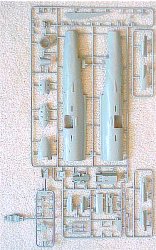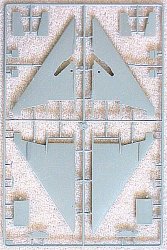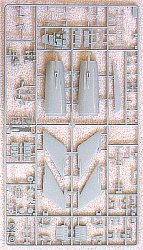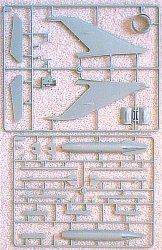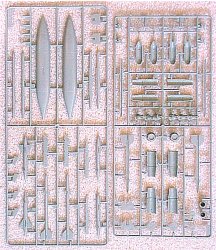Trumpeter 1/32 MiG-21F-13
By Michael Benolkin
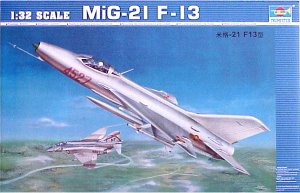 |
Background
The MiG-21 was the first generation of Mikoyan production aircraft designed to operate above Mach 2. Evolved from the MiG-19 series, the MiG-21 featured a delta wing and the R11F-300 afterburning engine. While the MiG-21 retained the nose intake of its predecessors, a movable centerbody shock cone was used to manage the volume and velocity of the air reaching the engine.
The first version of the MiG-21 to enter production was the MiG-21F, which featured two 30mm NR30 cannons mounted in fairings under the fuselage below the wings, one multipurpose pylon under each wing and a centerline pylon that was plumbed for a 490 liter external fuel tank. The MiG-21F carried the NATO designator Fishbed C.
The MiG-21F did not remain in production long as new improvements were incorporated into the airframe, including a wider chord vertical stabilizer and deletion of the port (left) 30mm gun. This version was internally designated at the MiG-21F-13 and carried the NATO designator Fishbed E.
Interestingly enough, these NATO reporting designators were assigned to each aircraft variant that was observed, (usually) in the order it was observed. During the height of the Cold War, Soviet aircraft designators were not widely known outside of the Soviet Block, so these NATO designators were used early on to refer to a specific aircraft type and variant. Somewhere along the way, the radar-equipped MiG-21PF was somehow identified before the MiG-21F-13, hence the former would be known as Fishbed D and the latter Fishbed E. But that is another story.
The early MiG-21s (MiG-21F, MiG-21F-13 and MiG-21PF) were all equipped with a novel aircrew escape system. Since the aircraft was purpose-built for supersonic combat and ejecting out of a supersonic aircraft is usually fatal, Mikoyan designers employed a forward-hinged canopy that would attach to the ejection seat during egress and cover the pilot, shielding him from the supersonic airflow. Unfortunately, the canopy did not always release again from the seat, trapping the pilot and preventing him from getting clear to open his parachute. As a result, all MiG-21s from the MiG-21PFM onward were equipped with a more 'conventional' canopy and escape system.
The MiG-21F-13 was widely used in the Soviet Air Force and was subsequently exported to air forces around the world. Of all of the versions of the MiG-21 produced, the MiG-21F-13 was really the sport model. It had virtually the best thrust-to-weight ratio of any production MiG-21 variant because it was not yet equipped with sophisticated radar, additional weapons stores and more avionics. The Chinese would also press the MiG-21F-13 into production as the J-7 and even export this aircraft as the F-7. The Pakistani Air Force is one of the major operators of the F-7.
The Kit
I never thought I'd see the day anyone would produce a decent injection-molded kit of the MiG-21F-13, much less in 1/32 scale. Trumpeter has really pulled out the stops and is producing quite a few previously overlooked subjects. Check out our Sprue Bits section for a look at Trumpeter's 2002 release list (and the list doesn't even reflect the 1/32 MiG-19s that are currently being released!).
When you open the box, you are presented with fewer parts than their previous MiG-21MF and MiG-21UM kits, but then again, the MiG-21F-13 is also a simpler aircraft. Trumpeter didn't take any shortcuts on the details. The MiG-21F-13 fuselage sports the correct profile for the smaller inlet nose and the smaller main wheel bulges above the wing, when compared to their MiG-21MF kit.
The wings are also correctly represented with the Fowler flaps that equiped all MiG-21 trainers and early MiG-21s (F, F-13 & PF). The later MiG-21s feature the engine-blown flaps that are correctly represented in the Trumpeter MiG-21MF kit.
The way this kit is laid out with the gun fairings, speed brakes and vertical stabilizer as separate parts, it wouldn't be difficult to back-date this kit to the MiG-21F.
As with the previously released MiG-21MF kit, the cockpit tub is a little soft on detail, though it would not be difficult to add details (or wait for a Cutting Edge or Black Box resin cockpit set). The early MiG-21s featured cockpits that were a mixture of black and dark gray, so one could use the kit cockpit as-is with no problems. On the other hand, if you want to show off some details, you can build your MiG-21F-13 as a remanufactured aircraft that features the cockpit in Russian turquoise green (check your references).
The kit still features the very detailed engine, which is a kit all unto itself. The only criticism that I have for this kit is with the engine, however, as it still has the strange spiral compressor face that is definitely not present on the R11F engine series. This 'feature' is also present in the MiG-21MF and MiG-21UM kits. If Trumpeter used one of the PLAAF J-7s as a basis for this kit, I wonder if this is one of the improvements that the Chinese adopted when they made their own versions of the R11F.
The MiG-21F-13 was armed with either two K-13 IR air-to-air missiles (copies of the early AIM-9 Sidewinder), two UB-16-57 rocket pods (16-shot pods firing 57mm rockets), or two unguided bombs, in addition to its 30mm cannon. The kit provides all of these options as well as some of the other weapons from the other MiG-21 kits, including the AA-1 Alkalai and the radar-guided version of the AA-2 Atoll. These are worth saving for future projects.
As with the other Trumpeter MiG-21s, there is a white-metal centerbody nose cone for ballast, and features white metal landing gear struts and rubber tires.
 Markings are provided for aircraft in Soviet, Chinese and North Vietnamese service. Two complete sets of red nose numbers are provided to recreate the aircraft you want to represent.
Markings are provided for aircraft in Soviet, Chinese and North Vietnamese service. Two complete sets of red nose numbers are provided to recreate the aircraft you want to represent.
In addition, one set of markings are also provided to represent '007', an Israeli MiG-21F-13 that was repainted and evaluated after it was 'received' from a defector. While most MiG-21F-13s were bare metal, 007 was a camouflaged aircraft, so for those of you that are avoiding bare metal projects, you have an option straight out of the box as well.
Conclusions
Thank you Trumpeter! At last we have an accurate model this early MiG-21! The only production model kit previously released of the MiG-21F-13 was an out-of-scale '1/72' Hasegawa kit.
Trumpeter has captured the lines and details of this aircraft and once again has offered it at a very reasonable price. As with the previously released 1/32 MiG-21MF and MiG-21UM kits from Trumpeter, this offering is very welcome addition to the 1/32 flightline.
This kit is highly recommended!
Bibliography
-
MiG-21 Fishbed, Yefim Gorgon & Bill Gunston, Aerofax, 1996, ISBN 1-85780-042-7
-
MiG-21, 4+ Publications, 1991, ISBN 80-900708-09
-
MiG-21 In Action, Don Linn & Don Sperling, Squadron/Signal Publications, 1993, ISBN 0-89747-290-X
-
Mikoyan MiG-21, Bill Gunston, Osprey, 1986, ISBN 0-85045-734-3

